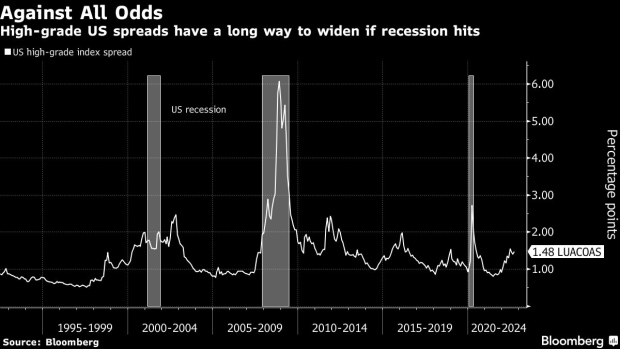Sep 27, 2022
Stock Bear Market Will Get Whole Lot Worse When Credit Cracks
, Bloomberg News

(Bloomberg) -- As crazy as it sounds, all the turmoil that’s ripped through Wall Street over the past week has still left debt markets in Corporate America relatively unscathed.
That’s bad news for stock dip-buyers hoping turmoil in the financial world will soon peak.
While greater than before the Federal Reserve’s latest jumbo rate hike, risk premiums for investment-grade debt remain modest compared to recent market stresses -- and the intensifying mayhem across bond and currency markets.
Now Goldman Sachs Group Inc. warns of a potential repricing of corporate bonds that risks adding fresh fuel to the stock rout, as current earnings estimates attach an “unjustifiably high probability” that the US economy will avoid a severe recession.
The bank’s warning looked prescient Tuesday, as another wave of Fed officials made clear that their work in taming price gains is far from over, snuffing out the 1.7% advance in the S&P 500 with the gauge closing 0.2% lower to a fresh bear-market low.
Margin pressure is increasing, the dollar’s relentless run threatens to shave $60 billion from corporate revenues and a darker climate for capital raising looks all but imminent as the yield on 10-year Treasuries jumps to within a whisker of 4%.
For Wall Street pros looking for signs of bearish capitulation, it suggests things have to get worse before they get better.
“A repricing of credit will just be another check mark on the negative side” for stocks, said Peter Boockvar, chief investment officer at Bleakley Advisory Group.
While yields have jumped to multiyear highs in sympathy with the sweeping Treasury selloff, spreads on US investment-grade bonds currently sit near 150 basis points. That’s lower than the levels notched in July and a far cry from some 370 basis points seen in March 2020. Meanwhile junk-risk premiums are hovering around 520 basis points, below July’s high-water mark.
The relative resilience contrasts with the turmoil sweeping other asset classes. In currency markets, the pound, the euro and the yen are all crumbling under the weight of a rampant US dollar. Treasury yields have soared to decade-highs across the curve. In the UK, 30-year gilts surged above 5% on Tuesday for the first time since 2002, raising fears of an incipient crisis of confidence in a developed-debt market.
To be sure, corporate default rates are still very relatively low. And even after a series of ultra-aggressive rate hikes, fresh data Tuesday, including core capital goods orders and consumer sentiment, suggests the economy can weather additional tightening, for now at least.
Yet stock valuations still imply a healthy outlook for profits that could be hard to achieve. Earnings for S&P 500 companies are projected to rise 6.4% to $239.40 a share in 2023, according to analyst estimates compiled by Bloomberg Intelligence.
All that suggests the market is still attributing “an unjustifiably high probability to a soft landing, leaving room for downward revisions in upcoming months,” wrote Goldman strategist Sienna Mori in a note.
Slower earnings growth coupled with a higher cost of capital will hurt the weakest companies, especially in the high-yield market, per Goldman, while Barclays Plc strategists anticipate that a wave of downgrades is barreling toward the US blue-chip bond market.
For now, the market isn’t yet seeing a wave of bankruptcies. But should the profit picture darken, buckle up for fresh market fireworks potentially, according to Shawn Cruz, head trading strategist at TD Ameritrade.
“It could become a self-fulfilling prophecy where a lot of these companies can’t borrow, can’t access credit, either because it’s simply not there or it’s too burdensome for them to do so -- and that can lead to some serious problems for pretty much any investor, asset class,” he said. “Equities are at the bottom of that capital stack and they’re going to feel the brunt of that.”
©2022 Bloomberg L.P.





